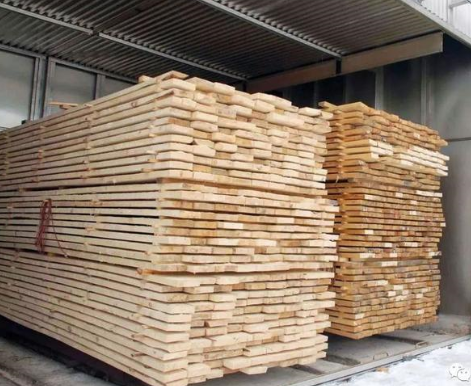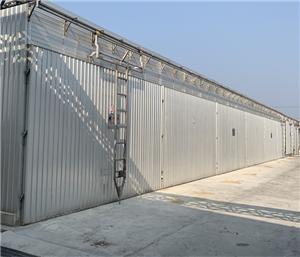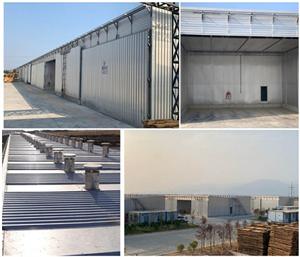Wood Drying Overview

There are many ways to dry wood. According to the discharge method of moisture in wood, it is divided into three types: thermal drying, mechanical drying and chemical drying. The actual wood production process uses thermal drying. Thermal drying can be divided into atmospheric drying (referred to as air drying, also known as natural drying) and artificial drying according to whether the drying conditions are artificially controlled or not. Artificial drying can be divided into kiln drying (including low temperature, conventional and high temperature kiln drying), dehumidification drying, solar drying, vacuum drying, high frequency and microwave drying, infrared radiation drying and contact (hot pressing) drying. These drying methods are outlined below.
(1) Atmospheric drying, referred to as air drying, means that the wood is piled up on the open space or in the shed, and the atmosphere is used as the heat and moisture transfer medium, and the heat of solar radiation is used to remove the moisture of the wood to achieve the purpose of drying. Air drying is divided into ordinary air drying and forced air drying. The forced air drying time can be shortened by about 1/2 to 2/3 compared with ordinary air drying, and the wood will not be moldy and discolored, and the drying quality is better, but the drying cost will increase by about 1/3. The advantages of atmospheric drying are: simple and easy to implement, energy saving, relatively economical, and can meet the requirements of air-dried materials. If it is combined with other drying methods such as kiln drying, it can also shorten the drying time, ensure the drying quality and reduce the drying cost. The disadvantage is that it is limited by natural conditions, the drying time is long, the final moisture content is high, the site is large, and the wood is vulnerable to bacteria and insects during air drying. At present, simple atmospheric drying is used less and less, but as a pre-drying method combined with other drying methods, it is still economically feasible in southern my country.
(2) Kiln drying refers to the method of drying wood by manually controlling the parameters of the drying medium in the drying kiln. According to the temperature of the drying medium, it can be divided into low-temperature kiln drying, conventional kiln drying and high-temperature kiln drying. The appropriate kiln drying method should be selected correctly according to the tree species, thickness, use and other conditions of the wood to be dried. The advantages of kiln drying are good drying quality, short drying cycle, flexible adjustment of drying conditions, easy to realize mechanization of loading, unloading and transportation, automatic adjustment of drying medium parameters, and wood can be dried to any final moisture content. The disadvantage is that the equipment and process are more complicated than air drying, the investment is larger, and the drying cost is higher.
(3) The difference between dehumidification (heat pump) drying and kiln drying is that part of the hot and humid air flows through the dehumidifier, first cooled to condense part of the water vapor into water and discharged, and at the same time recover the latent heat of vaporization of water vapor; After being heated, it flows into the pile and dries the wood. The advantage of dehumidification drying is that the energy consumption is significantly lower than that of conventional kiln drying, especially in the early stage of the drying process; there is basically no environmental pollution, and the drying quality is better. The disadvantage is that the drying temperature is low and the drying cycle is long; due to the use of electric energy, the drying cost is high; generally there is no steam generator, and it is difficult to perform humidity control.
(4) Vacuum drying means drying the wood in a closed container under negative pressure conditions. According to the operation mode, it can be divided into intermittent vacuum drying and continuous vacuum drying. The former is carried out alternately according to two stages of atmospheric pressure heating and negative pressure drying, with steam or hot water heating, and a few of them use flue gas or electric heating. The latter is continuous heating and vacuum at the same time, using a hot plate (with hot water as the heating medium), electric blanket or high-frequency dielectric heating. The advantage of vacuum drying is that it can speed up the drying speed at a lower temperature and ensure the drying quality. It is especially suitable for the drying of hard broad-leaved tree planks or squares with good permeability. The disadvantage is that the equipment is more complicated, the capacity is smaller, and the investment is larger.
(5) Solar drying Solar drying is to use the heat collector to absorb the sun's radiant energy to heat the air, and then to dry the wood through air convection heat transfer. Solar drying kilns can be divided into greenhouse type and external collector type. The drying speed of solar drying kiln is generally slower than that of air drying block and kiln drying, which varies with climate, tree species, structure and specific area of heat collector, etc. The outstanding advantage of solar drying is energy saving, inexhaustible solar energy can be used, and there is no environmental pollution; the operation cost is low, the drying degradation is less than air drying, the final moisture content is lower than air drying, and the drying quality is better. The disadvantage is that it is greatly affected by the climate, and the drying effect in high latitude areas is poor in winter; the equipment and equipment are similar to those of kiln drying, but the output of dry materials is much less than that of kiln drying.
(6) High-frequency and microwave drying uses wet wood as a dielectric and places it in a high-frequency or microwave electromagnetic field. Under the action of an alternating electromagnetic field, the wood molecules are polarized, friction generates heat, and the wood is dried. The high-frequency frequency used for wood drying is several to tens of MHZ, and the microwave frequency is 915 and 2450MHZ. The frequency of microwave is much higher than that of high-frequency electromagnetic waves, and the heating and drying speed of wood is much faster; but the penetration depth of wood is not as good as high-frequency electromagnetic waves. The application of high-frequency drying tends to be combined drying, such as high-frequency convection combined drying, high-frequency-vacuum combined drying, etc. The advantages of high-frequency and microwave drying are that the inside and outside of the wood are heated evenly at the same time, the drying speed is fast, the drying quality is good, and the natural color of the wood can be maintained. The disadvantage is that it uses electric energy as the heat source, the drying cost is high, and the equipment investment and maintenance costs are relatively large.
(7) Hot pressing (pressing plate) drying Place the wood between the hot pressing plates and apply a certain pressure to dry the wood by contact heating. It is characterized by fast heat transfer and drying speed, and the dried wood is smooth and smooth. However, hard broad-leaved trees that are difficult to dry are prone to defects such as cracking and shrinkage when drying. This method is suitable for the drying of fast-growing plantation wood, which can effectively prevent the warping of the wood and increase the density and strength of the wood.
Fujian Zhangping CHIQIN Technology Co. Ltd, is professional in wood drying over 20 years, covering Aluminum Wood Drying Kiln, Heat Pump Wood Drying Kiln without heat source, Veneer Drying Equipment, Food Drying Kiln, Kiln Components etc with high quality and reasonable price. Hope to establish business relationship with you!




